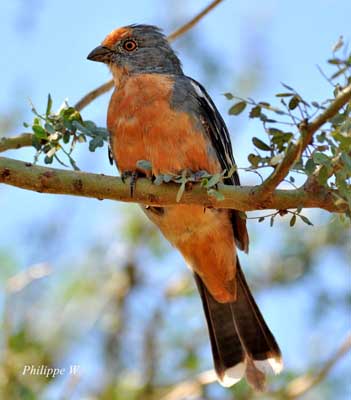PROTECTION / THREAT / STATUS:
The White-tipped Plantcutter is fairly common, and can be seasonally locally abundant.
The race “angustirostris” decreases due to fragmentation and degradation of bushy vegetation in the Bolivian highlands.
The nominate race is present in several protected areas in Argentina.
This species is not threatened at this moment.
Fr: Rara du Paraguay
All : Zweibinden-Pflanzenmäher
Esp: Cortarramas Argentino
Ital: Tagliafoglie pettirosso
Nd: Rosse Zaagvink
Port: Corta-ramos
Photos by Philippe et Aline Wolfer
GALERIE
Texte de Nicole Bouglouan
Sources :
HANDBOOK OF THE BIRDS OF THE WORLD Vol 9 - by Josep del Hoyo - Andrew Elliot - David Christie - Lynx Edicions - ISBN: 8487334695
BirdLife International (BirdLife International)
White-tipped Plantcutter
Phytotoma rutila
Passeriforme Order – Cotingidae Family
BIOMETRICS:
Length: 18-20 cm
weight: 30-57 g
DESCRIPTION:
The White-tipped Plantcutter differs from most of Passeriformes by its diet. This bird is herbivore, with a predominantly vegetal diet.
Its English and Spanish names illustrate very well this feeding behaviour involving “to cut the plants” and “cortar las ramas”.
Adult male has dark grey upperparts with faint pale grey streaks. Wings and tail are blackish. Wings show two white wingbars, but the lower is often less distinct than the other. Tail feathers are tipped-white, except the central pair.
Underparts are rufous, except the grey-brown sides and flanks. Underwing coverts are whitish. Undertail is dark grey and white-tipped.
On the head, forehead is rufous, whereas crown is dark grey. We can see a short crest on head top, unique in the family Cotingidae.
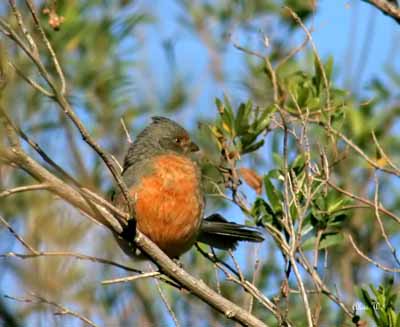
The bill is dark grey or blackish. It is short and stout, conical, with fine serrations along the cutting edges, adapted to its feeding habits. Eyes are pale brown, yellowish or hazel. Legs and feet are dark grey.
Female is very different with blackish-brown head and upperparts. Head is streaked white, whereas back is streaked buffish-grey. The blackish-brown wings show one or two narrow white wingbars and pale-edged tertials. Outer tail feathers are edged white.
Underparts are pale buff to ochraceous, conspicuously streaked dark brown. Eyes are pale brown.
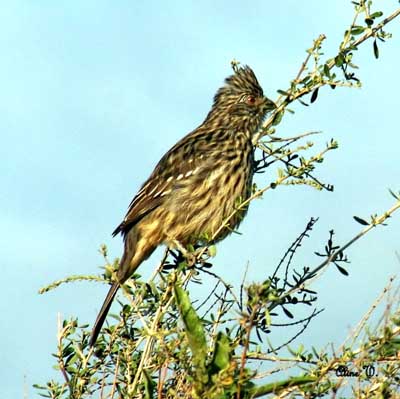
Juvenile has grey-brown upperparts with faintly brownish-tipped feathers. The upper wingbar is broader than lower. Underparts are buff-brown.
Immature male is well dark-streaked and flanks are rufous-buff.
Immature female resembles adult with more ochraceous vent.
We can find two subspecies:
P.r. angustirostris has stronger bill and broader white tail tip. This race occurs in highlands of C and S Bolivia, and N Argentina.
P.r. rutila occurs in W Paraguay, N and E Argentina and W Uruguay.
VOICE: SOUNDS BY XENO-CANTO
The White-tipped Plantcutter has strange voice, a mechanical “errrrrrrrrrrr” uttered by both sexes and repeated several times. This call may be followed by shorter and lower “errrr”. When foraging, these birds give scratchy sounds.
HABITAT:
The White-tipped Plantcutter frequents open woodlands, Chaco woodland (deciduous woodland with thick, thorny undergrowth), forest edges and riparian thickets, pampas, arid lowlands, montane scrub, thorny groves and bushes.
But this species is also seen in gardens, orchards and cultivated areas.
In most part of the range, it occurs from sea-level to 1800 metres of elevation, but in the Andes, it can be seen between 600 and 3600 metres.
RANGE:
See above in the subspecies rubric.
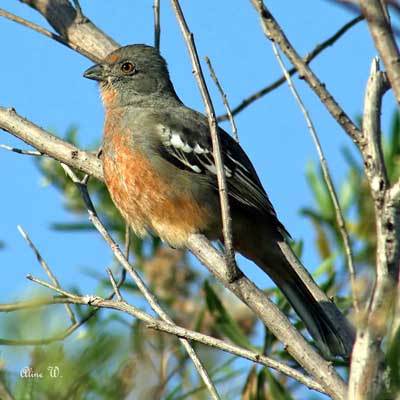
BEHAVIOUR:
The White-tipped Plantcutter feeds mainly on plant matter. This species is herbivore. Foliage is about 90% of the diet, but it also takes fruits and flowers, buds, shoots, seeds and leaves of numerous plant species.
They can forage in pairs and family groups, but also in flocks of several tens of birds. They search for food at 3-4 metres up in trees and foliage. They can be seen sometimes on the ground.
The White-tipped Plantcutter seems to live in pairs, and both adults feed and care the chicks.
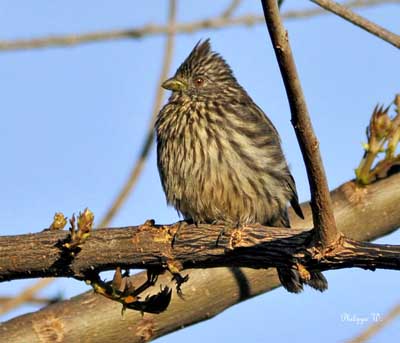
This species is resident, but some birds are partial migrants. Populations of the southern parts of the range move northwards after breeding, whereas the birds which breed at high elevations move to lower areas during the austral autumn.
FLIGHT:
The females of the family Cotingidae have shorter wings than males. If disturbed, it reaches another perch with heavy and noisy flight.
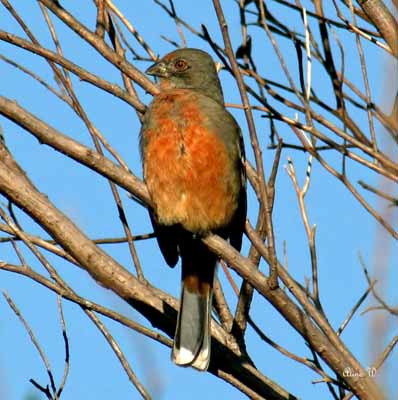
REPRODUCTION:
This species produces two broods per year, with the laying in January-February and September-December.
The White-tipped Plantcutter builds a simple basket-shaped nest of 10-17 cm in diameter and 5-10 cm height. It is placed on small branches. The cup is lined with root fibres and some grasses. The nest is often situated in thorny bush, small tree or shrub, between one and four metres above the ground.
Female lays 2-4 eggs and incubates during about two weeks. Both parents feed and care the chicks. The nesting period lasts 17 days.
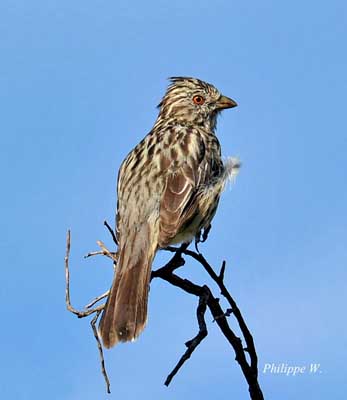
DIET:
The White-tipped Plantcutter feeds mainly on plant matter such as foliage. It feeds on buds, shoots and leaves of several plant species such as Lycium, Proposis, Celtis tala, Schinus longifolius and Acacia. It also takes fruits and flowers, and seeds from Proposis.
They feed while perched in vegetation, and also forage on the ground.
